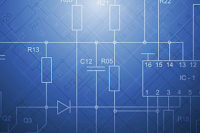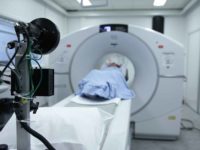In July of 2014, I authored the Engineered Systems article “Size Matters – Trends in Standby Power Systems for Health Care Facilities.” In that article, I explained the factors driving the trend for multibuilding health care campuses to use central standby generator installations consisting of large units with medium-voltage distribution. That article focused on issues to be considered during the design of such systems. In this article, I will pivot to an operations and maintenance perspective with a discussion of how testing may differ from what you’re used to for smaller, less-complex systems.
In this article, I will use the word “essential” instead of “emergency” or “standby” to refer to these power systems because it aligns with the current language used in the National Electrical Code and in National Fire Protection Association (NFPA) Standard 99, “Health Care Facilities.”
Figure 1 shows a simplified single-line diagram of a portion of a typical centrally supplied essential power system of the type this article will be discussing. Multiple large, engine-driven generators (1,500-3,000 kW) are connected to medium-voltage (4,160-13,800 V) paralleling switchgear. From this switchgear, distribution feeders are routed to step-down transformers at individual buildings, where the distribution voltage is reduced to lower voltages, such as 480/277 V or 208/120 V, for utilization within the building. The transfer switches serving the different branches of these essential power system are served from the low-voltage side of these transformers.
Know the Requirements
Maintenance and testing requirements for essential power systems in health care facilities are found in Paragraph 6.7.4 of NFPA 99. This paragraph references Chapter 8 of NFPA 110, “Emergency and Standby Power Systems,” extensively, which provides detail for the general requirements laid out in NFPA 99. This standard also defines the performance requirements that testing must verify. Hospital systems and other critical health care occupancies are classified as Type 10, Class X, Level 1, where “10” designates that power must be restored within 10 seconds, “X” is the required duration of operation (fuel supply), and Level 1 indicates that failure of the system to perform could result in loss of life or serious injury.
Another important organization influencing the maintenance and testing of essential power systems is the Joint Commission, an organization that accredits hospitals and other health care organizations, considering all aspects of patient care. The Joint Commission prescribes engineering requirements for health care facilities in its “Environment of Care” standards and for essential power systems specifically in standard EC.02.05.07, which also references the same NFPA 110 requirements as NFPA 99.
Testing requirements can generally be divided between those intended to verify operation of the generators and those intended to verify the operation of the automatic transfer switches. These requirements are summarized in Tables 1 and 2.
In addition to generator and transfer switch testing, circuit breakers between the alternate power source and the automatic transfer switches are required to be exercised monthly with the alternate source off. This frequency is increased to every six months for medium-voltage circuit breakers, which are also required to be tested under simulated overload conditions every two years. This test typically requires specialized equipment and outside personnel to complete.
The Joint Commission not only publishes requirements but conducts regular surveys of accredited facilities to audit compliance, which is a requirement to maintain accreditation. On more than one occasion, I have had clients report that the Joint Commission surveyor expressed uncertainty as to how this type of centrally supplied system should be tested and/or whether their test procedures were in compliance. In one case, this led to a request to review the facility’s test procedures; compare them to the requirements of NFPA 99, NFPA 110, and EC.02.05.07; and provide a formal compliance report that could be shared with surveyors in the future.
Alleviate Confusion with Test Mode
One aspect of these systems that creates confusion is that the paralleling switchgear is kept energized through one or more tie circuits from the normal (utility) power system at all times, as opposed to the typical 480-V generator paralleling scheme in which the paralleling switchgear is de-energized until a transfer switch loses normal power and signals the generators need to come on line. When voltage from the normal power system is lost, the controls open the tie circuit(s), start the generators, and re-energize the paralleling switchgear. This allows the system to provide essential power to all of the connected transfer switches without the need to receive a generator start signal from any of them. Effectively, the paralleling switchgear serves as an “upstream” transfer switch to the “downstream” transfer switches located in the buildings. One might think you could get by with no communications at all between the transfer switches and the paralleling switchgear controls but, that is not the case.
There are two reasons to design a system this way: 1) Should an incipient fault develop in a distribution feeder or step-down transformer, it will blow a fuse or trip a circuit breaker at the time it occurs rather than waiting until the circuit is energized due to a utility failure, allowing the repair to be completed while utility power is still available; 2) Should a local power outage occur in a single building or portion of a building, the affected transfer switches can supply power to their loads without the need to run a large generator at what may be a very low load for an extended period of time. Such operation at light load can result in condensation of corrosive components of the exhaust gases, or so-called “wet-stacking,” that is damaging to the engine. Wet-stacking is the reason minimum-load requirements are specified for the generator testing identified in Table 1.
It can often be difficult to achieve this minimum load because, to minimize the impact to hospital operations, generators are often exercised at times of reduced activity. Occupants are usually notified of testing in advance, which may lead to some equipment being turned off for concern that the transfer of power will adversely affect it. The ability to test generators monthly at or near the rated load can be a significant benefit of this type of central system. If the utility permits and the proper protection is designed into the system, the generators can be individually operated in parallel with the normal power system while it is tied to the utility, allowing the generator to be loaded by displacing power the facility would otherwise consume from the utility. This can provide a full load test of not only the engine-generator but critical auxiliary systems, such as fuel supply, engine cooling, and engine room HVAC.
NFPA 110 requires monthly testing of an essential power supply system to be initiated by either simulating a power outage with the test switch or interrupting the normal power supply to a selected automatic transfer switch. This should start the generators and bring them onto the bus, and the switch should transfer within 10 seconds, confirming the system’s ability to meet the Type 10 portion of its classification. Subsequently, the test switches on the other transfer switches in the system that are operated to place their loads on the generators. NFPA 110 requires that the transfer switch used to initiate the test each month be rotated so that, over time, the ability of each ATS to start the generators is verified.
If this test is performed with the system in normal conditions, it will neither verify performance per the 10-second criteria nor place essential power load on the generators. For this reason, the design of the system should include an alternate “test” mode in which the tie circuit between the normal power system and the paralleling switchgear can be opened without the paralleling controls responding to the resulting loss of voltage. In this mode of operation, the generators should respond only to the start signals from the ATSs, allowing the system to be tested per NFPA 110. This test mode is usually also required for initial approval of the system by the electrical inspector or other authority having jurisdiction as well as such approval of new buildings or transfer switches as they are connected to the system.
Don’t Forget the System Controls
So, one might think that placing a system into test mode for monthly generator exercises and meeting the other requirements of Tables 1 and 2 that are familiar from traditional systems would place the system in compliance, but that’s not quite the case. Paragraph 8.3.5 of NFPA 110 requires a maintenance program for paralleling switchgear that includes “verifying the system controls will operate as intended.” No specific frequency is cited and, because operating sequences for paralleling switchgear differ between installations, there is no detailed test procedure prescribed.
This leaves us with the question of how often and how extensively to test. The first question is more easily answered, as most facilities I’m familiar with perform some measure of testing of the paralleling controls monthly. The second question is more difficult to answer. Obviously, the basic functionality of sensing loss of voltage and bringing the generators on line should and can easily be tested simply by opening the circuit breaker(s) at the normal power switchgear that supply the paralleling switchgear. All of the generators should start, one of them should energize the paralleling switchgear within 10 seconds, and the others should synchronize and close their breakers within the system manufacturer’s specified time.
In addition to this basic functionality, these systems contain other important control sequences. Signals between the paralleling switchgear and the transfer switches are provided to delay the transfer of some equipment branch loads until multiple generators are in parallel to prevent overloading the first generator on line while the others are still synchronizing. Provisions to shed optional loads, or less-critical equipment branch loads if a generator becomes overloaded or fails, are required for many systems. Finally, systems may contain automatic controls to respond to contingencies, such as failure of a circuit breaker to open or close on command or failure to synchronize. It’s extremely difficult to fully test these functions in an operating system, as they may require that normal power be interrupted to all transfer switches simultaneously or that certain loads be interrupted for a significant period. Testing these functions can be time-intensive, and the ability of the system to automatically respond to a utility outage within the specified time may be compromised during the testing. For better or worse, in most cases, these more complex sequences are fully tested only when the system is initially commissioned or re-commissioned due to the addition of generator capacity.







